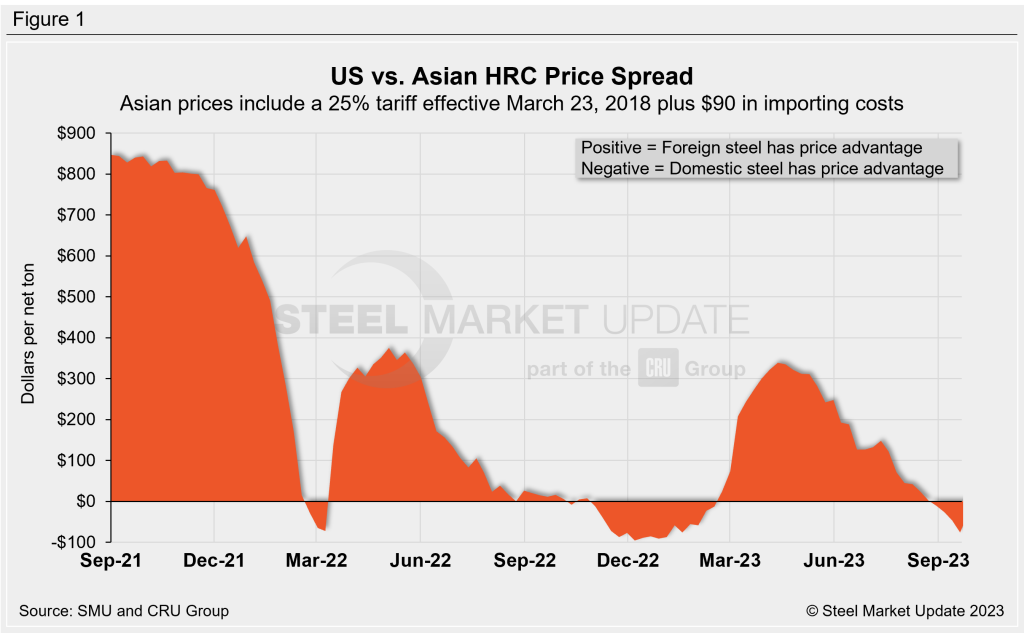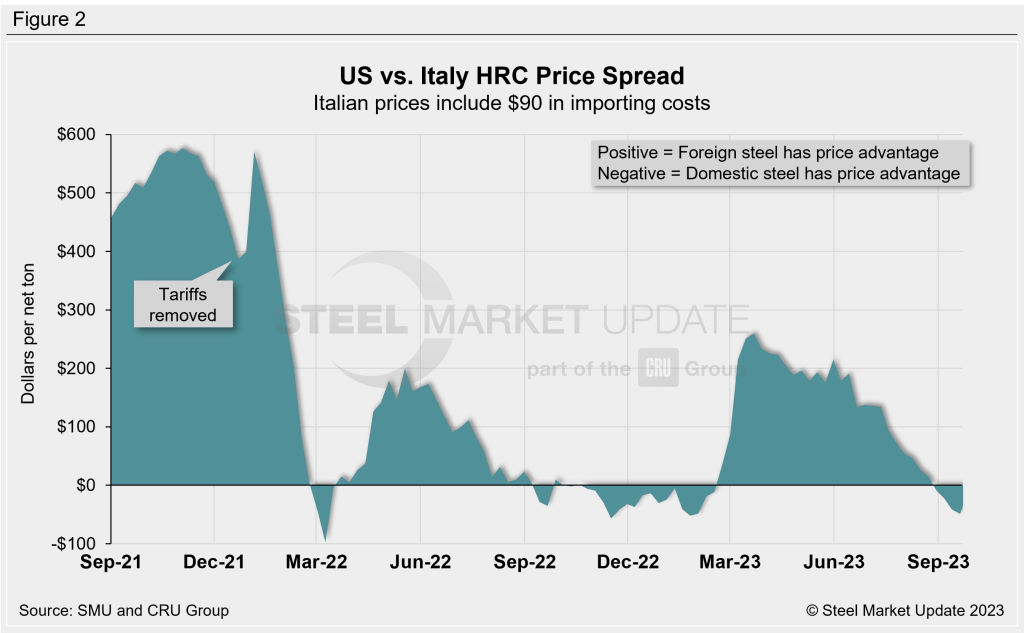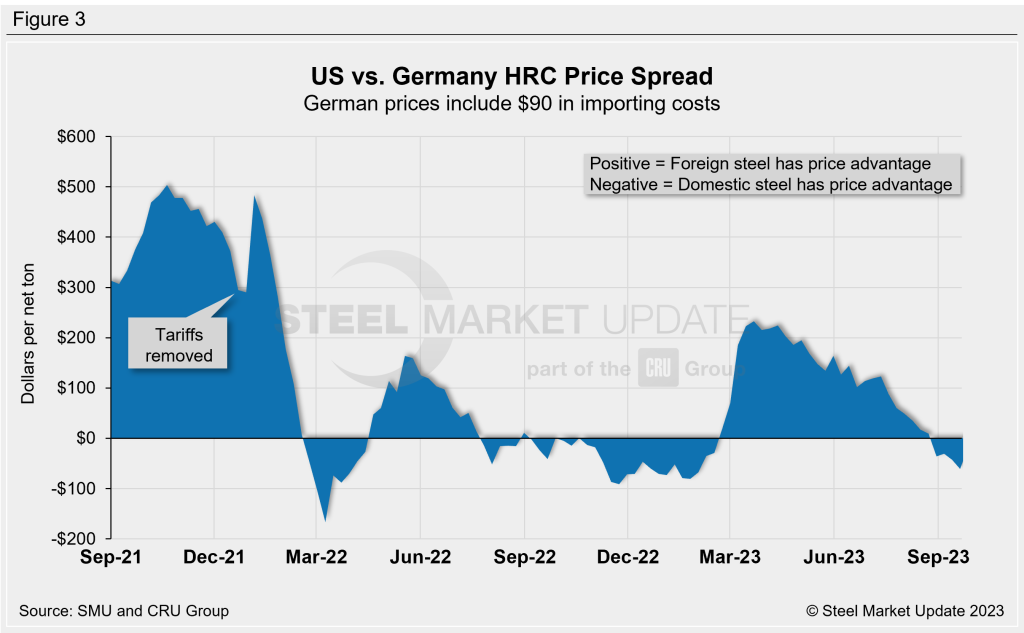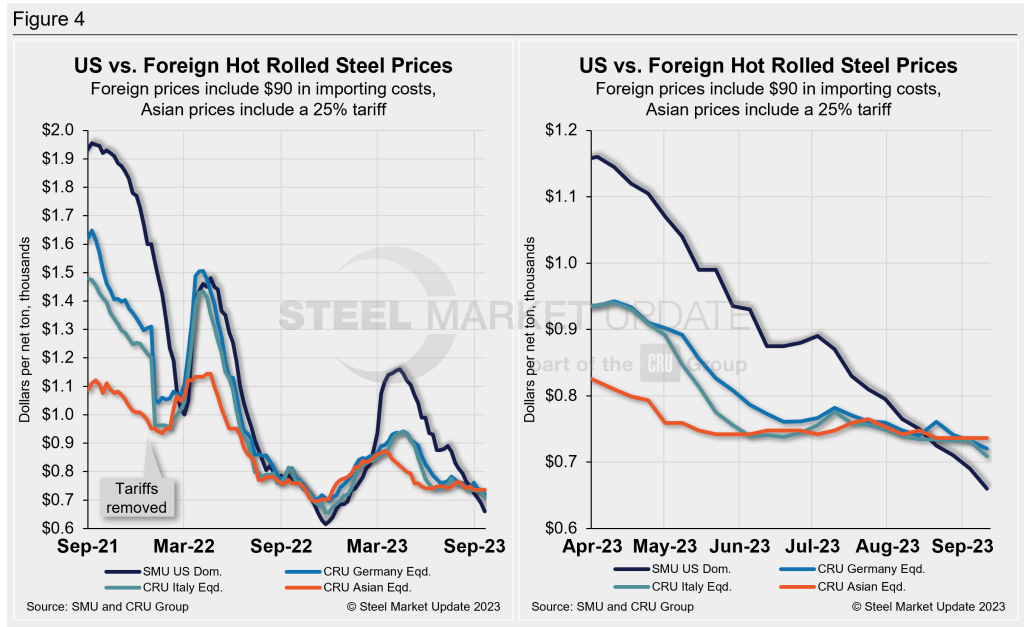SMU Data and Models

US Hot Band Now Even Cheaper Than Imported HRC
Written by David Schollaert
September 21, 2023
US hot-rolled coil (HRC) prices fell further relative to imported product this week. Domestic hot band remains cheaper than offshore HRC as US tags continue to sink at a sharper rate than those overseas, according to SMU’s latest foreign vs. domestic price analysis.
Domestic HRC prices have eroded for nearly six months, far outpacing a similar trend for offshore hot band. The premium US hot-rolled held over imported material has turned by nearly 25% since early July. Imported product is now roughly 10% more expensive than stateside hot band.
Since the beginning of Q1, US HRC had been significantly more expensive than imports, peaking in mid-April, and ballooning to a 23% premium on average. Imports are now more expensive, given that US tags have fallen by $230 per ton ($11.50 per cwt) just since mid-July. However, offshore product is down on average just $32 per ton over the same period.
HRC tags stateside are at an average of $660 per net ton this week, declining by $30 from the previous week. They’ve slipped to their lowest level since the first week of December 2022. Domestic prices are now down $500 per ton since peaking this year at $1,160 per ton back in April.
Overseas prices have also been weakening since April, but declines have been less pronounced. That has caused domestic HRC pricing to reverse quickly and become noticeably cheaper.
Domestic hot band is now 9.4% cheaper than foreign material. It was 15% more expensive just about two months ago.
SMU uses the following calculation to identify the theoretical spread between foreign HRC prices (delivered to US ports) and domestic HRC prices (FOB domestic mills): Our analysis compares the SMU US HRC weekly index to the CRU HRC weekly indices for Germany, Italy, and east and southeast Asia ports. This is only a theoretical calculation because costs to import can vary greatly, influencing the true market spread.
In consideration of freight costs, handling, and trader margin, we add $90 per ton to all foreign prices to provide an approximate CIF US ports price to compare to the SMU domestic HRC price. Buyers should use our $90-per-ton figure as a benchmark and adjust up or down based on their own shipping and handling costs. If you import steel and want to share your thoughts on these costs, we welcome your insight at david@steelmarketupdate.com.
Asian Hot-Rolled Coil (East and Southeast Asian Ports)
As of Thursday, Sept. 21, the CRU Asian HRC price was $517 per ton, unchanged from the previous week. Adding a 25% tariff and $90 per ton in estimated import costs, the delivered price of Asian HRC to the US is approximately $736 per ton. The latest SMU hot rolled average for domestic material is $660 per ton.
Now $76 per ton cheaper, US-produced HRC has lost its parity with steel imported from Asia. And it’s trending cheaper ahead of the fourth quarter.

Italian Hot-Rolled Coil
Italian HRC prices fell week over week (WoW,), down $23 per ton this week to roughly $619 per ton. After adding import costs, the delivered price of Italian HRC is approximately $709 per ton.
Domestic HRC is now theoretically $49 per ton cheaper than imported Italian HRC. That is a far cry from late March, when US tags were $260 per ton more expensive than those of imported Italian hot band.

German Hot-Rolled Coil
CRU’s latest price for German HRC declined last week, down $12 per ton WoW to $631 per ton. After adding import costs, the delivered price of German HRC is roughly $721 per ton.
Domestic HRC is now theoretically $61 per ton cheaper than imported German HRC. That’s down $18 per ton WoW, and still a $294-per-ton change vs. late March when German hot band was 20% cheaper than US product.

Figure 4 compares all four price indices. The chart on the right zooms in to highlight the difference in pricing from the second quarter of this year to the present.

Notes: Freight is important in deciding whether to import foreign steel or buy from a domestic mill. Domestic prices are referenced as FOB the producing mill, while foreign prices are CIF the port (Houston, NOLA, Savannah, Los Angeles, Camden, etc.). Inland freight, from either a domestic mill or from the port, can dramatically impact the competitiveness of both domestic and foreign steel. It’s also important to factor in lead times. In most markets, domestic steel will deliver more quickly than foreign steel.
Effective Jan. 1, 2022, the traditional Section 232 tariff no longer applies to most imports from the European Union. It has been replaced by a tariff rate quota (TRQ). Therefore, the German and Italian price comparisons in this analysis no longer include a 25% tariff. SMU still includes the 25% Section 232 tariff on foreign prices from other countries. We do not include any antidumping (AD) or countervailing duties (CVD) in this analysis.

David Schollaert
Read more from David SchollaertLatest in SMU Data and Models

SMU Survey: Buyers’ Sentiment rebounds from multi-year low
Both of SMU’s Steel Buyers’ Sentiment Indices edged higher this week. Current Sentiment rebounded from a near five-year low, while Future Sentiment rose to a two-month high

SMU flat-rolled market survey results now available
SMU’s latest steel buyers market survey results are now available on our website to all premium members.

SMU Survey: Sheet lead times pull back after early-June blip, plate holds
Following the uptick seen two weeks ago, lead times eased this week for all four sheet products tracked by SMU, while plate lead times held steady, according to this week’s market survey.

SMU Survey: Pricing power abruptly shifts to steel buyers
The majority of steel buyers responding to our latest market survey say domestic mills are more willing to talk price on sheet and plate products than they were earlier this month. Sheet negotiation rates rebounded across the board compared to early June, while our plate negotiation rate hit a full 100%.

Service centers: Mill orders down marginally in May
SMU’s Mill Order Index (MOI) declined for a third straight month in May, but only marginally.
